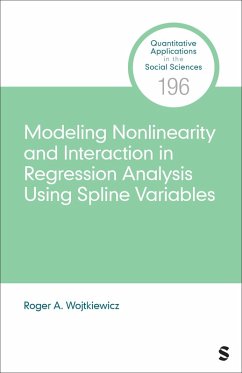Roger A. Wojtkiewicz
Modeling Nonlinearity and Interaction in Regression Analysis Using Spline Variables
Roger A. Wojtkiewicz
Modeling Nonlinearity and Interaction in Regression Analysis Using Spline Variables
- Broschiertes Buch
- Merkliste
- Auf die Merkliste
- Bewerten Bewerten
- Teilen
- Produkt teilen
- Produkterinnerung
- Produkterinnerung
This volume addresses the issue of linear constraints in regression modeling. Author Roger A. Wojtkiewicz uses the method of knotted spline variables (also known as piecewise linear regression) and a new method involving group spline variables to model nonlinearity in a variety of situations. Using spline variables to model nonlinearity allows researchers to specify unrestricted models for models that involve interval variables, allowing for greater flexibility in modeling any possible interaction.
Andere Kunden interessierten sich auch für
![Fundamentals of Regression Modeling Fundamentals of Regression Modeling]() Fundamentals of Regression Modeling1.232,99 €
Fundamentals of Regression Modeling1.232,99 €![Interaction Effects in Factorial Analysis of Variance Interaction Effects in Factorial Analysis of Variance]() James JaccardInteraction Effects in Factorial Analysis of Variance46,99 €
James JaccardInteraction Effects in Factorial Analysis of Variance46,99 €![Latent Variables and Factor Analysis Latent Variables and Factor Analysis]() Latent Variables and Factor Analysis1.328,99 €
Latent Variables and Factor Analysis1.328,99 €![Understanding Regression Assumptions Understanding Regression Assumptions]() William D BerryUnderstanding Regression Assumptions49,99 €
William D BerryUnderstanding Regression Assumptions49,99 €![Correlation and Regression Analysis Correlation and Regression Analysis]() Correlation and Regression Analysis1.354,99 €
Correlation and Regression Analysis1.354,99 €![Using Computers in Qualitative Research Using Computers in Qualitative Research]() Nigel G Fielding / Raymond M Lee (eds.)Using Computers in Qualitative Research70,99 €
Nigel G Fielding / Raymond M Lee (eds.)Using Computers in Qualitative Research70,99 €![Using Qualitative Methods to Answer Your Research Question Using Qualitative Methods to Answer Your Research Question]() Paul OliverUsing Qualitative Methods to Answer Your Research Question37,99 €
Paul OliverUsing Qualitative Methods to Answer Your Research Question37,99 €-
-
This volume addresses the issue of linear constraints in regression modeling. Author Roger A. Wojtkiewicz uses the method of knotted spline variables (also known as piecewise linear regression) and a new method involving group spline variables to model nonlinearity in a variety of situations. Using spline variables to model nonlinearity allows researchers to specify unrestricted models for models that involve interval variables, allowing for greater flexibility in modeling any possible interaction.
Hinweis: Dieser Artikel kann nur an eine deutsche Lieferadresse ausgeliefert werden.
Hinweis: Dieser Artikel kann nur an eine deutsche Lieferadresse ausgeliefert werden.
Produktdetails
- Produktdetails
- Verlag: Sage Publications Inc Ebooks
- Erscheinungstermin: 14. Mai 2025
- Englisch
- Abmessung: 215mm x 139mm
- ISBN-13: 9781071950340
- ISBN-10: 1071950347
- Artikelnr.: 73390909
- Herstellerkennzeichnung
- Libri GmbH
- Europaallee 1
- 36244 Bad Hersfeld
- gpsr@libri.de
- Verlag: Sage Publications Inc Ebooks
- Erscheinungstermin: 14. Mai 2025
- Englisch
- Abmessung: 215mm x 139mm
- ISBN-13: 9781071950340
- ISBN-10: 1071950347
- Artikelnr.: 73390909
- Herstellerkennzeichnung
- Libri GmbH
- Europaallee 1
- 36244 Bad Hersfeld
- gpsr@libri.de
Roger A. Wojtkiewicz is a professor in the Department of Sociology at Ball State University in Muncie, Indiana. He spent the first 12 years of his career in the Department of Sociology at Louisiana State University and has since been at Ball State where he served as department chairperson for 12 years. At LSU, he taught undergraduate statistics and a graduate course in regression modeling in the PhD program. At Ball State, he has taught both the first and second semester courses in the statistics sequence in the master's program. He was trained as a quantitative methodologist in the graduate sociology program at the University of Wisconsin-Madison. He is author of Elementary Regression Modeling: A Discrete Approach published by Sage Publications in 2017.
Series Editor Introduction
Acknowledgments
About the Author
Chapter 1: Introduction
Main Focus of the Book
The Necessity to Provide Theoretical Justifications for Interactions
Plan of the Book
Chapter 2: Basics of Spline Variables
Derivation of Knotted Spline Model
General Equation for Knotted Spline Model
Empirical Example for Knotted Spline Model
Derivation of Group Spline Model
General Equation for Group Spline Model
Empirical Example of Group Spline Model
Conceptual Difference Between Knotted Splines and Group Splines
Summary
Chapter 3: Applications of Spline Variables
Modeling an Interval Variable With a Smaller Number of Values
Modeling an Interval Variable With a Larger Number of Values
Problem in Using Dummy Variables to Model Interval Variable
Advantages of Spline Variables Over Polynomial Variables
Interrupted Regression and Spline Variables
General Equation for Interrupted Regression Model
Empirical Example of Interrupted Regression Model
Summary
Chapter 4: Interaction Between Interval and Categorical Variables
Derivation of Model for Interval Conditioned on Categorical Interaction
General Equation for Interval Conditioned on Categorical Interaction Model
Empirical Example for Interval Conditioned on Categorical Interaction Model
Derivation of Model for Categorical Conditioned on Interval Interaction
General Equation for Categorical Conditioned on Interval Interaction Model
Empirical Example for Categorical Conditioned on Interval Interaction Model
Summary
Chapter 5: Interaction Between Interval Variables
Derivation of Model for Interval and Interval Interaction With Fewer Values
General Equation for Interval Conditioned on Interval Interaction
Empirical Example for Interval and Interval Interaction With Fewer Values
Derivation of Model for Interval and Interval Interaction With Many Values
Empirical Example for Interval and Interval Interaction With Many Values
Summary
Chapter 6: Concluding Remarks
Key Points
Final Comments
Appendix 1: Example of Derivation of Interaction Model With Interval
Variable Conditioned on Categorical Variable From Dummy Variable Model
Appendix 2: Example of Derivation of Interaction Model With Interval
Variable Conditioned on Interval Variable From Dummy Variable Model
References
Index
Acknowledgments
About the Author
Chapter 1: Introduction
Main Focus of the Book
The Necessity to Provide Theoretical Justifications for Interactions
Plan of the Book
Chapter 2: Basics of Spline Variables
Derivation of Knotted Spline Model
General Equation for Knotted Spline Model
Empirical Example for Knotted Spline Model
Derivation of Group Spline Model
General Equation for Group Spline Model
Empirical Example of Group Spline Model
Conceptual Difference Between Knotted Splines and Group Splines
Summary
Chapter 3: Applications of Spline Variables
Modeling an Interval Variable With a Smaller Number of Values
Modeling an Interval Variable With a Larger Number of Values
Problem in Using Dummy Variables to Model Interval Variable
Advantages of Spline Variables Over Polynomial Variables
Interrupted Regression and Spline Variables
General Equation for Interrupted Regression Model
Empirical Example of Interrupted Regression Model
Summary
Chapter 4: Interaction Between Interval and Categorical Variables
Derivation of Model for Interval Conditioned on Categorical Interaction
General Equation for Interval Conditioned on Categorical Interaction Model
Empirical Example for Interval Conditioned on Categorical Interaction Model
Derivation of Model for Categorical Conditioned on Interval Interaction
General Equation for Categorical Conditioned on Interval Interaction Model
Empirical Example for Categorical Conditioned on Interval Interaction Model
Summary
Chapter 5: Interaction Between Interval Variables
Derivation of Model for Interval and Interval Interaction With Fewer Values
General Equation for Interval Conditioned on Interval Interaction
Empirical Example for Interval and Interval Interaction With Fewer Values
Derivation of Model for Interval and Interval Interaction With Many Values
Empirical Example for Interval and Interval Interaction With Many Values
Summary
Chapter 6: Concluding Remarks
Key Points
Final Comments
Appendix 1: Example of Derivation of Interaction Model With Interval
Variable Conditioned on Categorical Variable From Dummy Variable Model
Appendix 2: Example of Derivation of Interaction Model With Interval
Variable Conditioned on Interval Variable From Dummy Variable Model
References
Index
Series Editor Introduction
Acknowledgments
About the Author
Chapter 1: Introduction
Main Focus of the Book
The Necessity to Provide Theoretical Justifications for Interactions
Plan of the Book
Chapter 2: Basics of Spline Variables
Derivation of Knotted Spline Model
General Equation for Knotted Spline Model
Empirical Example for Knotted Spline Model
Derivation of Group Spline Model
General Equation for Group Spline Model
Empirical Example of Group Spline Model
Conceptual Difference Between Knotted Splines and Group Splines
Summary
Chapter 3: Applications of Spline Variables
Modeling an Interval Variable With a Smaller Number of Values
Modeling an Interval Variable With a Larger Number of Values
Problem in Using Dummy Variables to Model Interval Variable
Advantages of Spline Variables Over Polynomial Variables
Interrupted Regression and Spline Variables
General Equation for Interrupted Regression Model
Empirical Example of Interrupted Regression Model
Summary
Chapter 4: Interaction Between Interval and Categorical Variables
Derivation of Model for Interval Conditioned on Categorical Interaction
General Equation for Interval Conditioned on Categorical Interaction Model
Empirical Example for Interval Conditioned on Categorical Interaction Model
Derivation of Model for Categorical Conditioned on Interval Interaction
General Equation for Categorical Conditioned on Interval Interaction Model
Empirical Example for Categorical Conditioned on Interval Interaction Model
Summary
Chapter 5: Interaction Between Interval Variables
Derivation of Model for Interval and Interval Interaction With Fewer Values
General Equation for Interval Conditioned on Interval Interaction
Empirical Example for Interval and Interval Interaction With Fewer Values
Derivation of Model for Interval and Interval Interaction With Many Values
Empirical Example for Interval and Interval Interaction With Many Values
Summary
Chapter 6: Concluding Remarks
Key Points
Final Comments
Appendix 1: Example of Derivation of Interaction Model With Interval
Variable Conditioned on Categorical Variable From Dummy Variable Model
Appendix 2: Example of Derivation of Interaction Model With Interval
Variable Conditioned on Interval Variable From Dummy Variable Model
References
Index
Acknowledgments
About the Author
Chapter 1: Introduction
Main Focus of the Book
The Necessity to Provide Theoretical Justifications for Interactions
Plan of the Book
Chapter 2: Basics of Spline Variables
Derivation of Knotted Spline Model
General Equation for Knotted Spline Model
Empirical Example for Knotted Spline Model
Derivation of Group Spline Model
General Equation for Group Spline Model
Empirical Example of Group Spline Model
Conceptual Difference Between Knotted Splines and Group Splines
Summary
Chapter 3: Applications of Spline Variables
Modeling an Interval Variable With a Smaller Number of Values
Modeling an Interval Variable With a Larger Number of Values
Problem in Using Dummy Variables to Model Interval Variable
Advantages of Spline Variables Over Polynomial Variables
Interrupted Regression and Spline Variables
General Equation for Interrupted Regression Model
Empirical Example of Interrupted Regression Model
Summary
Chapter 4: Interaction Between Interval and Categorical Variables
Derivation of Model for Interval Conditioned on Categorical Interaction
General Equation for Interval Conditioned on Categorical Interaction Model
Empirical Example for Interval Conditioned on Categorical Interaction Model
Derivation of Model for Categorical Conditioned on Interval Interaction
General Equation for Categorical Conditioned on Interval Interaction Model
Empirical Example for Categorical Conditioned on Interval Interaction Model
Summary
Chapter 5: Interaction Between Interval Variables
Derivation of Model for Interval and Interval Interaction With Fewer Values
General Equation for Interval Conditioned on Interval Interaction
Empirical Example for Interval and Interval Interaction With Fewer Values
Derivation of Model for Interval and Interval Interaction With Many Values
Empirical Example for Interval and Interval Interaction With Many Values
Summary
Chapter 6: Concluding Remarks
Key Points
Final Comments
Appendix 1: Example of Derivation of Interaction Model With Interval
Variable Conditioned on Categorical Variable From Dummy Variable Model
Appendix 2: Example of Derivation of Interaction Model With Interval
Variable Conditioned on Interval Variable From Dummy Variable Model
References
Index








